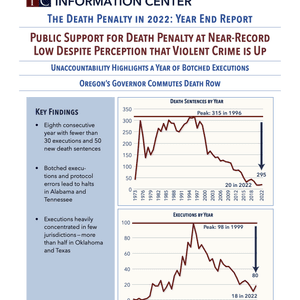
DPI’s new series focuses on academic research and articles in the field of capital punishment. This month’s article is “Sacred Victims: Fifty Years of Data on Victim Race and Sex as Predictors of Execution,” in The Journal of Criminal Law and Criminology, co-authored by Professors Scott Phillips (Department of Sociology & Criminology), Justin Marceau, Sam Kamin, and a J.D. program alumna, Nicole King, from the Sturm College of Law at the University of Denver.
The authors’ hypothesis is that “the victim-based disparities in death sentences and executions documented in previous work, including [Professor David] Baldus’s, are driven not by race alone, but by the combination of the victim’s race and sex.” (p.73) Their findings support this hypothesis and, what is more, showcase that as the defendant moves from sentencing towards execution, the negative impact of race and gender (especially when the victim was a white woman) becomes more salient. The district attorney was more likely to seek death, the authors found, the jury was more likely to impose death, and the condemned defendant was more likely to be executed if the victim is a white woman. (p.73) They also provide a potential alternative explanation “that the prosecution is more careful in trials involving white female victims,” thus leading to fewer reversals and higher rates of execution. (p.95) In addition, the authors evaluate the geography of these disparities and potential historical context, concluding that “[I]n every former Confederate state, those who killed a white woman were more likely than other killers to be executed. The lowest disparity was in Florida, where killers of white female victims were executed at about 1.9 times the rate that would be expected based on death eligibility; the highest disparity was 4.2 times the expected rate in Louisiana.” (p.104)
As an outcome of logistic regressions, the authors found that “the odds of a death sentence were sixteen times greater if the victim was a white woman than if the victim was a Black man.” (p.67) Among those who were executed, the authors found that 30% were executed for the killing of a white woman, compared with 19% if the victim was a white man, 10% if the victim was a Black woman, and 0% if the victim was a Black man. By using the FBI’s Supplemental Homicide Report (25,547 homicides reported to the FBI in Georgia between 1976 and 2019), the authors also contend that their findings can be extrapolated to other states.
Disparities first identified by Professor Baldus in his landmark Georgia study continue to be prevalent in contemporary data, pointing to both a potential bias in capital punishment sentencing and execution and the enduring nature of that bias. The results from Phillips et al. utilized DPI’s extensive Census data.
Scott Phillips, Justin F. Marceau, Sam Kamin, and Nicole King. “Sacred Victims: Fifty Years of Data on Victim Race and Sex as Predictors of Execution.” Journal of Criminal Law and Criminology 114, no. 2 (2024): 67.
Photo: Court Room by Kelly Sikkema, Unsplash.
Public Opinion
Sep 03, 2024

Articles of Interest: The New York Times Editorial Board Argues United States “Does Not Need the Death Penalty”
Public Opinion
Nov 15, 2022

